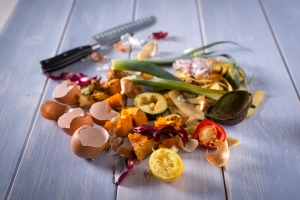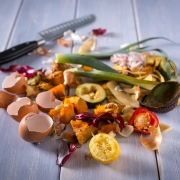Composting and Food Waste Reduction
A Law with Ambitious Goals
At the beginning of 2022, the new state law Short-Lived Climate Pollutants, also known as Senate Bill (SB) 1383 went into effect. The law is a statewide effort to reduce the amount of organic materials such as food, paper products, and plant trimmings discarded into landfills. Because organic materials decompose in landfills to produce methane and other greenhouse gases, which are the aforementioned “short-lived climate pollutants”, the goal is to slow and reduce the effects of the climate crisis.
The law requires all residents and commercial businesses to subscribe to regular collection of organic materials (green bin service) in addition to recycling and garbage. All organic materials, including spoiled left-over foods, fruit and vegetable scraps, meat, bones, dairy products, food-soiled napkins, and plant trimmings can no longer be discarded in the black (garbage) bin, but should be placed in the green bin which is sent to composting facilities.
Large food producing businesses have additional requirements to donate excess food to feed people as an effort to combat food insecurity. These businesses are defined below as Tier 1 Entities, who must start donating food in 2022, and Tier 2 Entities, who must start in 2024.
TIER 1 COMMERCIAL ENTITIES (2022)
- Supermarkets
- Grocery stores
- Food service providers (with contracts)
- Food distributors
- Wholesale food vendors
TIER 2 COMMERCIAL ENTITIES (2024)
- Restaurants >250 seats or >5,000 sq ft
- Hotels with on-site food facility and >200 rooms
- Health facilities with on-site food facility and >100 beds
- Large venues or events with average >2,000 people per day of operation
- Local education agencies with on-site food facility
Use the Compost You Create

As far as climate strategies go, redirecting organic materials from the landfill to composting facilities is just as important as using the compost created to replenish soils. The climate crisis is happening due to an excess of carbon in the form of methane (CH3) and carbon dioxide (CO2) in the atmosphere. Most state and federal policies focus their attention on reducing carbon emissions, which only slows the climate crisis. To stop or even reverse the climate crisis, sequestering carbon back into the soil and rocks is necessary. If preventing organic materials from entering landfills can be likened to turning off the faucet, applying compost to soil is like wiping up the spill.
Soil with the addition of compost has a much richer diversity of microorganisms, a more porous density, and a larger amount of nutrients such as nitrogen, phosphorus, and potassium. Plants are therefore able to grow more extensive root systems and have better access to water, all of which correlate to superior plant health and larger plant size. The larger the plant, the more carbon dioxide from the atmosphere is converted into plant sugars, woody material, and elemental carbon in the soil.
Even better than using compost purchased from a retail store is using local compost. Zero Waste Sonoma organizes regular compost giveaway events for free throughout Sonoma County, where the compost is made from the organic materials collected from residential green bins. Events can be found at: www.zerowastesonoma.gov/calendar. Alternatively, creating your own compost through a backyard hot pile method or through vermicomposting works just as well. Information and resources to get started are on this page: www.zerowastesonoma.gov/home-composting.
Make Waste Reduction a Priority
Although composting and recycling are good practices to keep, they are still resource and energy intensive, which means waste reduction should always take priority. In terms of food, according to a 2020 study published in the American Journal of Agricultural Economics, “Estimating Food Waste as Household Production Inefficiency” (https://onlinelibrary.wiley.com/doi/abs/10.1002/ajae.12036) , the average U.S. household wastes 31.9% of what they purchase annually. Imagine buying 3 bags of groceries but leaving one in the parking lot. This may take the form of forgotten leftovers in the back of the fridge, spoiled produce, bread gone moldy on the counter, or meat products purchased during a sale but now have freezer burn. The researchers found that households with higher food waste tended to have more healthful diets and higher incomes while households with lower levels of waste tended to draw up shopping lists.
With that in mind, here are a few suggestions for reducing food waste at home:
- Shop with a list and avoid purchasing perishable foods in bulk.
- Cook only as much as you can eat to avoid leftovers.
- Eat and use all parts of the plant or animal. For example, cauliflower leaves, kale stems, and cilantro stems are full of flavor and tender after cooking. IKEA’s free Scraps Book (https://www.ikea.com/ca/en/files/pdf/58/9f/589f2b5d/the-scrapsbook.pdf) of recipes offers unique suggestions.
- Store foods properly to extend shelf lives
- Eat the most perishable foods first. Having a basket or section of the fridge at eye level with a label, “eat me first” may help.
- Get online inspiration and have a few go-to recipes that are flexible with the ingredients. Chili/soup, casseroles, rice bowls, omelets, fried rice, chilaquiles, and curry are some examples.
- The Sonoma County Master Food Preservers offers free workshops and educational resources to help extend and preserve the life of food that could otherwise be waste: https://ucanr.edu/sites/MFPSC
- Making small lifestyle changes like composting, recycling, and reducing the amount of food wasted may seem insignificant and small, but their combined efforts can make a big difference in the face of a climate crisis.
This article was authored by Xinci Tan, Organics Program Manager with Zero Waste Sonoma, on behalf of the City of Healdsburg for RRWA. RRWA is an association of local public agencies in the Russian River Watershed that have come together to coordinate regional programs for clean water, habitat restoration, and watershed enhancement.




